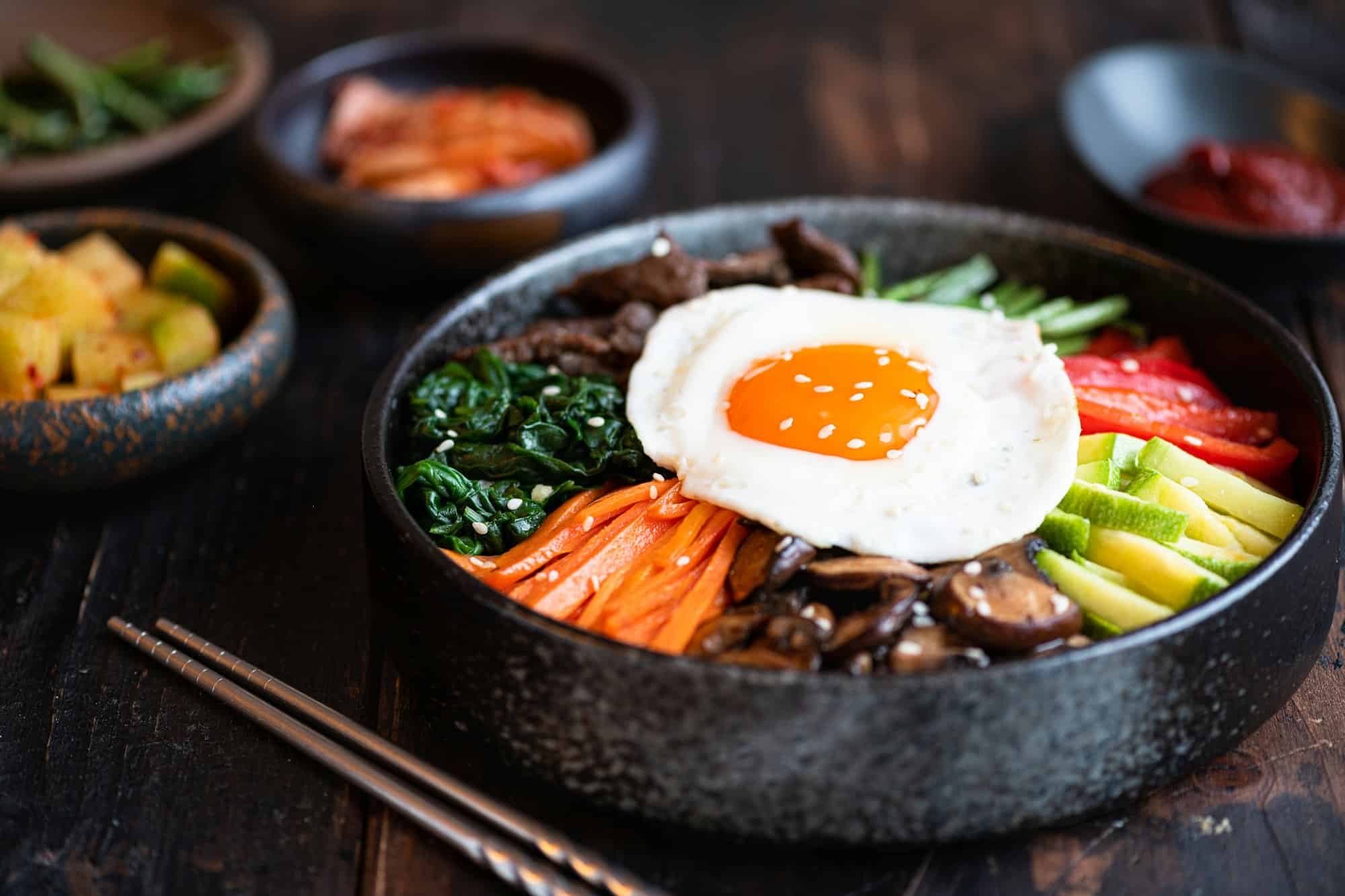What’s the Best Way to Create a Flavor-Packed Korean Bibimbap with Gochujang Sauce?

The Korean culinary landscape is a rich tapestry of bold flavors, unique textures, and vibrant colors. One dish that encapsulates this perfectly is bibimbap, a traditional Korean dish that is as diverse and complex as the culture from which it originates. A simple translation of bibimbap is "mixed rice," but this dish is far from ordinary. With meat, vegetables, rice, and a spicy gochujang sauce, bibimbap is a complete meal in a bowl. This article will guide you through a recipe to create a delicious bibimbap with a rich, flavorful gochujang sauce that will transport you straight to the heart of Seoul.
Discovering Bibimbap: An Overview
Bibimbap, a traditional Korean dish, is a symphony of flavors and textures that work together to create a harmonious blend in each bite. It starts with a base of steamed short-grain rice, upon which a variety of sautéed and seasoned vegetables, marinated beef, and a fried egg are arranged. The final touch is a dollop of gochujang, a fermented red chili paste that adds a spicy-sweet kick.
A découvrir également : What’s the Key to a Perfectly Balanced Gourmet Waldorf Salad with Candied Walnuts?
The beauty of bibimbap lies in its adaptability. You can customize the ingredients as per your liking and dietary restrictions. Traditionally, bibimbap includes ingredients like spinach, bean sprouts, carrots, and shiitake mushrooms. You can also add protein such as tofu, chicken, or beef. Bibimbap is served in a heated stone or earthenware bowl called a "dolsot", which creates a crispy rice crust at the bottom – a favorite element for many bibimbap lovers.
Gathering the Ingredients for Bibimbap
Creating a delicious bibimbap starts with gathering the right ingredients. The key here is to source fresh, quality ingredients, as the flavor of each component is crucial to the overall taste of the dish.
Sujet a lire : How to Bake Gourmet Espresso Chocolate Chip Cookies with a Sea Salt Finish?
For the bibimbap, you will need:
- 2 cups short-grain rice
- 200g of thinly sliced beef
- 2 cups of spinach
- 2 cups of bean sprouts
- 2 carrots, julienned
- 2 shiitake mushrooms, sliced
- 4 eggs
- 2 tsp of sesame oil
- Salt, to season
For the gochujang sauce, you’ll need:
- 2 tbsp gochujang
- 1 tbsp sesame oil
- 1 tbsp sugar
- 1 tbsp water
- 1 tsp vinegar
- 1 clove of garlic, minced
Creating the Perfect Bibimbap Bowl
After gathering the ingredients, it’s time to create your bibimbap masterpiece. Start by cooking the rice as per the instructions on the package. While the rice is cooking, you can prepare the vegetables and beef.
In a pan, heat a splash of oil over medium heat and add the beef. Cook for about 2-3 minutes until well browned, then remove from the pan and set aside. In the same pan, add the spinach and a pinch of salt. Cook for about 2 minutes until wilted, then remove and set aside. Repeat this process with the bean sprouts, carrots, and mushrooms.
In a separate pan, heat a little oil and cook the eggs until the whites are set, but the yolks are still runny.
To assemble, place a portion of rice at the bottom of each bowl. Arrange the cooked vegetables and beef in individual sections on top of the rice. Place the fried egg in the center and drizzle with sesame oil.
Mixing the Gochujang Sauce
The gochujang sauce is what gives bibimbap its characteristic spicy-sweet flavor. This sauce is a blend of gochujang, sesame oil, sugar, water, vinegar, and minced garlic.
To make the sauce, simply whisk together all the ingredients until well combined. Then, adjust the taste as desired. Some people like their sauce sweeter, so you may want to add a bit more sugar. Others prefer a spicier sauce, in which case you can add more gochujang. The choice is yours!
Once your bibimbap is assembled and your gochujang sauce is ready, you can drizzle the sauce over the top of the bibimbap or serve it on the side for people to add as they wish.
Savoring Your Bibimbap
Once you’ve assembled your bibimbap and prepared your gochujang sauce, the final step – and arguably the most rewarding – is to savor your creation. Mix all the ingredients together, ensuring that the gochujang sauce evenly coats the rice, meat, and vegetables.
As you savor each bite, appreciate the diverse flavors and textures – the sweetness of the carrots, the earthiness of the mushrooms, the crunchiness of the bean sprouts, the tenderness of the beef, the creaminess of the egg yolk, and the spiciness of the gochujang sauce.
Creating this flavor-packed Korean bibimbap with gochujang sauce may require some time and effort, but the end result – a delicious, balanced meal filled with a variety of flavors and textures – is undoubtedly worth it.
Variations in the Bibimbap Recipe
There is more than one way to savor bibimbap, a signature Korean dish. There are a plethora of variations, each with its unique twist, catering to different tastes and dietary preferences. For instance, if you’re a vegetarian or vegan you can opt for a vegan bibimbap. Simply swap the beef with tofu or add more vegetables of your choice. You can also try different kinds of mushrooms, like shitake or oyster, for an added depth of flavor.
In some regions, seafood bibimbap is popular. This variation incorporates seafood such as shrimp, squid, or scallops. The inclusion of these ingredients gives the dish a hint of the sea, completely transforming the flavor profile of the bibimbap.
If you prefer a lighter version of bibimbap, you can make a few wholesome replacements. Brown rice can be used instead of white rice, and soy sauce can be used as a substitute for gochujang sauce if you’re looking for a less spicy version.
Don’t forget about the garnish! For an authentic touch, sprinkle toasted sesame seeds over the dish before serving. You can also experiment with other garnishes like crushed seaweed, green onions, or even a drizzle of rice vinegar for an extra tang.
Remember, the beauty of bibimbap lies in its versatility. So don’t be afraid to experiment and create a bibimbap that’s uniquely yours!
A Culinary Journey to the Heart of Korean Cuisine
Bibimbap is more than just a dish; it’s a culinary journey that takes you straight to the heart of Korean cuisine. The preparation and assembly of the dish may seem intricate at first, but it’s part of the joy of creating authentic Korean food.
When cooking bibimbap, you’re not just mixing ingredients; you’re blending flavors, textures, and colors to create a dish that’s visually appealing and palate-pleasing. Each ingredient has a purpose and adds to the overall harmony of the dish. The crispiness of the bean sprouts, the tenderness of the beef, the richness of the yolk, and the spiciness of the gochujang sauce all contribute to the gastronomic experience.
In conclusion, creating a flavor-packed Korean bibimbap with gochujang sauce at home is a rewarding culinary adventure. It’s a chance to explore the authentic flavors of Korea and create a dish that’s adaptable to your taste preferences. The process may take some time and effort, but every bite of the final product is a testament to the richness of Korean cuisine. And as you relish your homemade bibimbap, you’ll realize that it’s not just about the destination (the final dish), but also about the journey (the process of making it). Enjoy your culinary journey with bibimbap!
